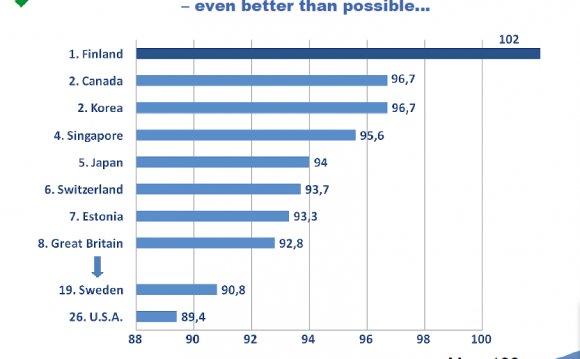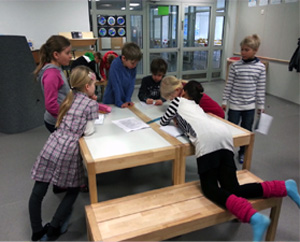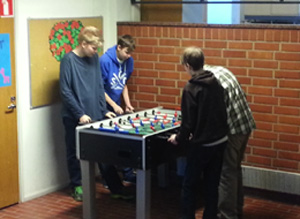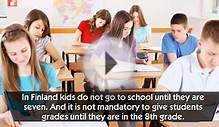
 By Sophia Faridi
By Sophia Faridi
Most educators have probably found themselves wishing for a simpler solution to the hardships and inequities of the U.S. education system. I recently got the once-in-a-lifetime opportunity to attend the Oppi Festival in Helsinki, Finland, with a group of seven U.S. educators to learn more about the Finnish school system and the lessons it might offer.
During the trip, our group had the chance to visit several innovative schools. While I can’t say that I uncovered some mysterious holy grail of education, I did discover something that I had never considered before: the importance of happy teaching and happy learning.
The teachers and students that I observed were happy. Students seemed to actually be enjoying their learning experiences, and teachers appeared satisfied and valued.
It made me wonder: “What makes school in Finland such an enjoyable experience for students and teachers?” Here are 13 factors that I identified.
Students in Finland work together frequently, and the material they study is important to them.
—Sophia Faridi
1. A heavy emphasis on play. In Finland, people believe that children learn through play, imagination, and self-discovery, so teachers not only allow but encourage play. Development of the whole person is highly valued, especially in the early years. Even at the high school level, you can see students playing foosball or videogames in the student center.
2. No high-stakes standardized testing. Finnish schools believe more test preparation means less time for free thinking and inquiry. Accountability is measured at the classroom level by the experts—teachers.
3. Trust. This was perhaps the greatest difference I observed. The Finnish government trusts their municipalities, the municipalities trust school administrators, administrators trust teachers, teachers trust students, and in return, parents and families trust teachers. There is no formal teacher-evaluation system. Teachers, similar to doctors in the U.S., are trusted professionals.
4. Schools don’t compete with one another. There are no school evaluations since it is believed that all schools should be good. Non-competitive school structures result in no need for school-choice programs.
 5. Out-of-this-world teacher prep programs. Part of the reason why teachers are so trusted in Finland is that becoming a teacher is an extremely rigorous and prestigious process. Only the best of the best are accepted into education school. In addition to having high test scores, candidates must pass an interview investigating their integrity, passion, and pedagogy. Universities are committed to finding candidates that are the right fit for the teaching profession. Their programs are research-based, and teachers finish with master’s degrees, including a published thesis.
5. Out-of-this-world teacher prep programs. Part of the reason why teachers are so trusted in Finland is that becoming a teacher is an extremely rigorous and prestigious process. Only the best of the best are accepted into education school. In addition to having high test scores, candidates must pass an interview investigating their integrity, passion, and pedagogy. Universities are committed to finding candidates that are the right fit for the teaching profession. Their programs are research-based, and teachers finish with master’s degrees, including a published thesis.
6. Personal time is highly valued. Every 45 minutes, students have the legal right to 15 minutes of free time. Finns believe that students’ capacity for engagement and learning is most successful when they have a chance to unwind and refocus. In turn, students work productively during class time, with the understanding that their needs to play, talk, or even read quietly will be met shortly. Going outside frequently also encourages greater physical fitness.
In Finland, schools emphasize play, and students are encouraged to play during the school day all the way through high school.
7. Less is more. Students do not start school until the age of seven. School days are also shorter. Most elementary students only attend school for four to five hours per day. High school students, similar to college students, only attend the classes that are required of them. So while one student might have an 8 a.m. Swedish class, another might not start school until 10 a.m.
8. Emphasis on quality of life. The Finnish system recognizes that happy teachers are good teachers, and overworked teachers will not be at the top of their game. Teachers prep from home and only teach to students about 20 hours per week.
9. Semi-tracked learning. After age 16, students choose gymnasium (academic-based) or vocational school. However, both paths are highly respected in Finnish society. The vocational school we visited was an amazing state-of-the-art facility with hands-on learning infrastructures that surpass most American universities. Students graduating from either type of high school may attend university.
10. National standards are valued. Finland uses a national set of standards that are similar to the Common Core State Standards. Teachers have complete autonomy over curriculum and how the standards are implemented.
11. Grades are not given until 4th grade. Evaluation of early learners focuses on metacognition and learning how to learn.
12. Ethics is taught in the primary grades. While many students learn their ethics curriculum through religion class, even nondenominational or nonreligious students are required to take ethics courses.
13. Collaboration and collaborative environments are strongly emphasized. The infrastructure of schools is designed to promote collaboration. Classrooms branch off from a shared learning area where students from various classes and grade levels work together and teachers can interact in a common space. High school students have all sorts of cozy nooks and crannies to work together comfortably on campus, and students move freely around the building with minimal supervision. The teachers’ lounge was a literal greenhouse allowing for sunshine and plants to thrive. With access to a massage chair and computer lab, teachers feel relaxed and comfortable when working together.
Students in Finland appear happy, engaged, and invested in their work.
Perhaps what struck me most about schools in Finland was the relevant, genuine learning taking place right before my eyes. For example, I had the chance to sit down with a group of high school seniors working on a project examining U.N. extradition trials. Without any teacher present, students were engaged simply because the subject was important to them.
While I’m still not sure exactly how Finland has managed to cast such a positive light on education (or how to replicate that attitude), I did walk away with one tool to begin the conversation about improving American education. As one Finnish principal explained, “When a student struggles, the question is not what’s wrong with the student or what’s wrong with the teacher. The question is, what’s wrong with the system?”
I think this is just the beginning of many questions we need to ask ourselves as we develop our own models for improving schooling for all U.S. students and teachers.
RELATED VIDEO












